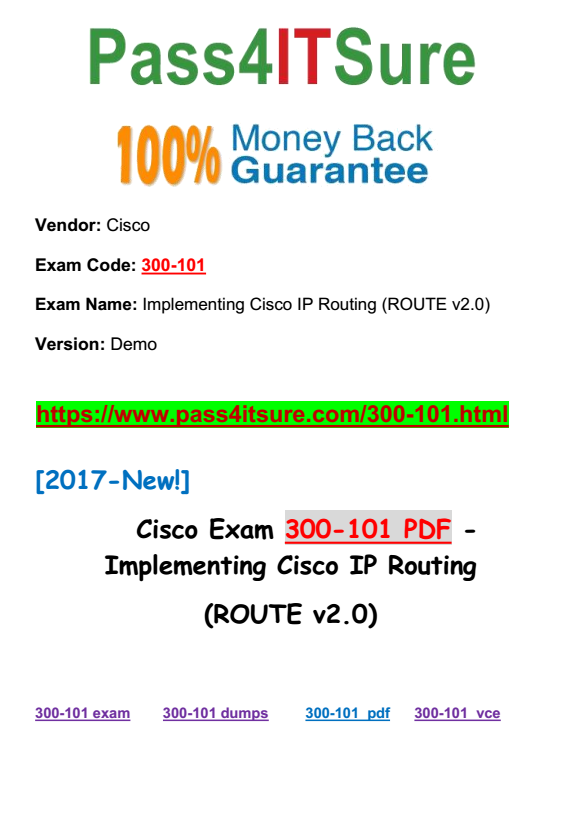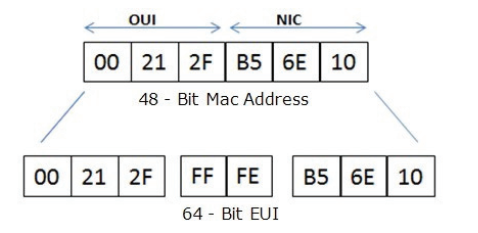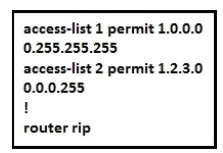What is the best way to pass the Cisco 300-135 exam?”Implementing Cisco IP Routing” also known as 300-101 exam, is a Cisco certification which covers all the knowledge points of the real Cisco exam. Pass4itsure Cisco 300-101 dumps exam questions answers are updated (484 Q&As) are verified by experts. Most important Cisco 300-101 dumps practice exam new questions Implementing Cisco IP Routing
The associated certifications of 300-101 dumps is CCDP. Most of the candidates weary with the unnecessarily long details of certification topics. Therefore Pass4itsure experts have intentionally designed its https://www.pass4itsure.com/300-101.html dumps study material in a small and amazing style.
Exam Code: 300-101
Exam Name: Implementing Cisco IP Routing
Q&As: 484
[Hottest Pass4itsure 300-101 Dumps Questions From Google Drive]: https://drive.google.com/open?id=0BwxjZr-ZDwwWWDdYaFM0SVFwMTA
[Hottest Pass4itsure 210-260 Dumps Questions From Google Drive]: https://drive.google.com/open?id=0BwxjZr-ZDwwWU0xad3NvRWR4Qzg

Pass4isture Latest and Most Accurate Cisco 300-101 Dumps Exam Q&As:
QUESTION 3
An engineer has configured a router to use EUI-64, and was asked to document the IPv6 address of the router. The router has the following interface parameters:
mac address C601.420F.0007
subnet 2001:DB8:0:1::/64
Which IPv6 addresses should the engineer add to the documentation?
A. 2001:DB8:0:1:C601:42FF:FE0F:7
B. 2001:DB8:0:1:FFFF:C601:420F:7
C. 2001:DB8:0:1:FE80:C601:420F:7
D. 2001:DB8:0:1:C601:42FE:800F:7
300-101 exam Correct Answer: A
Explanation
Explanation/Reference:
Explanation:
Extended Unique Identifier (EUI), as per RFC2373, allows a host to assign iteslf a unique 64-Bit IP Version 6 interface identifier (EUI-64). This feature is a key benefit over IPv4 as it eliminates the need of manual configuration or DHCP as in the world of IPv4. The IPv6 EUI-64 format address is obtained through the 48-bit MAC address. The Mac address is first separated into two 24-bits, with one being OUI (Organizationally Unique Identifier) and the other being NIC specific. The
16-bit 0xFFFE is then inserted between these two 24-bits to for the 64-bit EUI address. IEEE has chosen FFFE as a reserved value which can only appear in EUI- 64 generated from the EUI-48 MAC address. Here is an example showing how the Mac Address is used to generate EUI.

Next, the seventh bit from the left, or the universal/local (U/L) bit, needs to be inverted. This bit identifies whether this interface identifier is universally or locally administered. If 0, the address is locally administered and if 1, the address is globally unique. It is worth noticing that in the OUI portion, the globally unique addresses assigned by the IEEE has always been set to 0 whereas the locally created addresses has 1 configured. Therefore, when the bit is inverted, it maintains its original scope (global unique address is still global unique and vice versa). The reason for inverting can be found in RFC4291 section 2.5.1.
QUESTION 4
For security purposes, an IPv6 traffic filter was configured under various interfaces on the local router. However, shortly after implementing the traffic filter, OSPFv3 neighbor adjacencies were lost. What caused this issue?
A. The traffic filter is blocking all ICMPv6 traffic.
B. The global anycast address must be added to the traffic filter to allow OSPFv3 to work properly.
C. The link-local addresses that were used by OSPFv3 were explicitly denied, which caused the neighbor relationships to fail.
D. IPv6 traffic filtering can be implemented only on SVIs.
Correct Answer: C
Explanation
Explanation/Reference:
Explanation:
OSPFv3 uses link-local IPv6 addresses for neighbor discovery and other features, so if any IPv6 traffic filters are implemented be sure to include the link local address so that it is permitted in the filter list.
QUESTION 5
What is the purpose of the autonomous-system {autonomous-system-number} command?
A. It sets the EIGRP autonomous system number in a VRF.
B. It sets the BGP autonomous system number in a VRF.
C. It sets the global EIGRP autonomous system number.
D. It sets the global BGP autonomous system number.
300-101 dumps Correct Answer: A
Explanation
Explanation/Reference:
Explanation:
To configure the autonomous-system number for an Enhanced Interior Gateway Routing Protocol (EIGRP) routing process to run within a VPN routing and forwarding (VRF) instance, use the autonomous-system command in address-family configuration mode. To remove the autonomous-system for an EIGRP routing process from within a VPN VRF instance, use the no form of this command. autonomous-system autonomous-system-number no autonomous-system autonomous-system-number
QUESTION 6
Which type of traffic does DHCP snooping drop?
A. discover messages
B. DHCP messages where the source MAC and client MAC do not match
C. traffic from a trusted DHCP server to client
D. DHCP messages where the destination MAC and client MAC do not match
Correct Answer: B
Explanation
Explanation/Reference:
Explanation:
The switch validates DHCP packets received on the untrusted interfaces of VLANs with DHCP snooping enabled. The switch forwards the DHCP packet unless any of the following conditions occur (in which case the packet is dropped): The switch receives a packet (such as a DHCPOFFER, DHCPACK, DHCPNAK, or DHCPLEASEQUERY packet) from a DHCP server outside the network or firewall. The switch receives a packet on an untrusted interface, and the source MAC address and the DHCP client hardware address do not match. This check is performed only if the DHCP snooping MAC address verification option is turned on. · The switch receives a DHCPRELEASE or DHCPDECLINE message from an untrusted host with an entry in the DHCP snooping binding table, and the interface information in the binding table does not match the interface on which the message was received. The switch receives a DHCP packet that includes a relay agent IP address that is not 0.0.0.0. To support trusted edge switches that are connected to untrusted aggregation-switch ports, you can enable the DHCP option-82 on untrusted port feature, which enables untrusted aggregation- switch ports to accept DHCP packets that include option-82 information. Configure the port on the edge switch that connects to the aggregation switch as a trusted port.
QUESTION 7
Refer to the exhibit.

Which command only announces the 1.2.3.0/24 network out of FastEthernet 0/0?
A. distribute list 1 out
B. distribute list 1 out FastEthernet0/0
C. distribute list 2 out
D. distribute list 2 out FastEthernet0/0
300-101 pdf Correct Answer: D
Explanation
Explanation/Reference:
Explanation:
Access list 2 is more specific, allowing only 1.2.3.0/24, whereas access list 1 permits all 1.0.0.0/8 networks. This question also asks us to apply this distribute list only to the outbound direction of the fast Ethernet 0/0 interface, so the correct command is “distribute list 2 out FastEthernet0/0.”
You never experience any fatigue in going through the whole curriculum as it happens in the case of the recommended academic sources for Pass4itsure 300-101 dumps exam preparing. Reverse to this, preparing with Pass4itsure Cisco 300-101 study material will provide you soothing feeling. Moreover, you cover up the whole https://www.pass4itsure.com/300-101.html dumps in very short period of time.